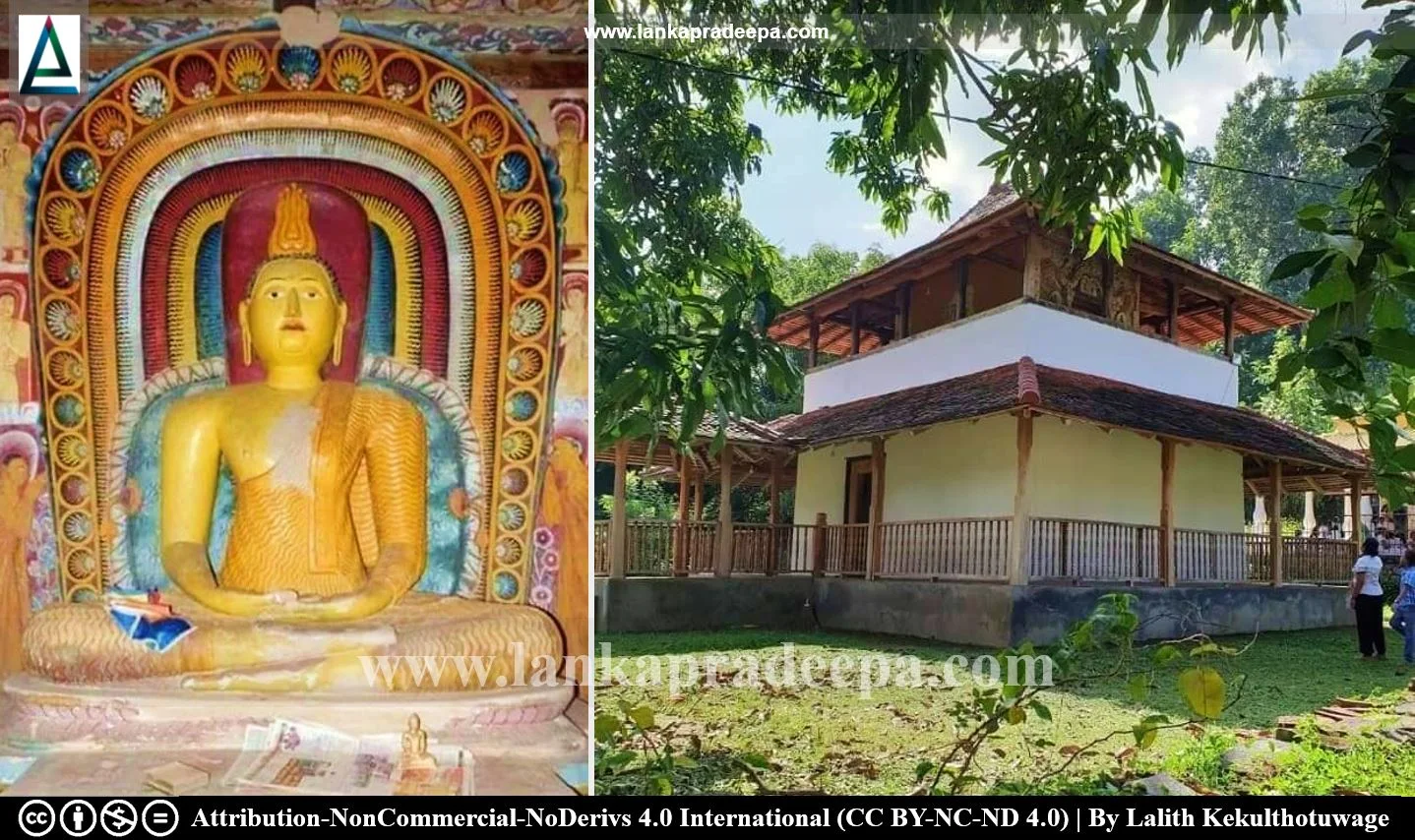
Walalgoda Purana Tempita Viharaya (Sinhala: වළල්ගොඩ පුරාණ ටැම්පිට විහාරය) is a Buddhist temple situated in Walalgoda village in Ratnapura District, Sri Lanka.
History
The history of this temple runs back to the period of the kings of Ruhuna principality of the 3rd century B.C. who reigned from Magama [(present Tissamaharama) Abeyawardana, 2002; Gnanawimala Thera, 1967]. During the 18th century, one of the chapter houses had been located on this Vihara premises (Abeyawardana, 2002). The Tempita Viharaya of this temple was constructed in 1774 by Alahakoon Mudiyanse Rala of Omalpe (the builder of Omalpe Tempita Viharaya ?) and by Valalgoda Gunatilaka Jayawardana Vijayakoon Mudiyanse (Gnanawimala Thera, 1967; Silva & Chandrasekara, 2021). It is said that Siamese Upali Thera established the Sima (consecrated boundary) for this Viharaya during the reign of King Kirti Sri Rajasinha [(1747-1781 A.D.) Gnanawimala Thera, 1967; Silva & Chandrasekara, 2021; Wijayawardhana, 2010].
The Walalgoda Pin Pathraya records the meritorious acts performed in connection with the construction of this temple (Abeyawardana, 2002). Also, two records issued in 1774 and 1782 reveal several bestowments made to the temple by local chieftains (Gnanawimala Thera, 1967).
Tempita Viharaya
Tempita Viharas were popular in many Buddhist temples during the Kandyan Period. These structures were usually built on a wooden platform resting on bare stone pillars or stumps which are about 1-4 feet tall. The roof is generally made of timber and held by wooden stumps. The walls are usually made of wattle and daub and form the main enclosed shrine room containing Buddhist sculptures and murals in the Kandyan style. Some Tempita Viharas have narrow verandas and ambulatories circulating the main enclosed space. The construction of these buildings started in the 17th century and lasted until the end of the 19th century (Wijayawardhana, 2010).
Walalgoda Tempita Viharaya
The Tempita Viharaya of Walalgoda temple is a two-storey building with an Uposathaghara on the lower level and the sanctum on the upper level (Silva & Chandrasekara, 2021; Wijayawardhana, 2010). Both levels have ambulatory around the chambers and a small Mandapa (pavilion) has been built at the entry to the lower level. The main seated Buddha is placed in the sanctum of the upper level and its weight is carried by an extremely thick wall on the lower level (Silva & Chandrasekara, 2021). The exterior and interior walls of the sanctum are painted with murals depicting Buddhist themes such as Jataka tales, 104 Arhats, and the figures of the God Saman, Kataragama, Vishnu and Vibhishana (Abeyawardana, 2002; Silva & Chandrasekara, 2021).
The paintings of the Walalgoda Tempita Viharaya belong to the Kandyan art tradition and can be compared to those at Omalpe Tempita Viharaya (Silva & Chandrasekara, 2021). The painting style is considered to be of the southern or Ruhunu School as the costumes of figures show European influence (Silva & Chandrasekara, 2021).
A protected site
The ancient Tempita image house in the Walalgoda Purana Viharaya premises situated in the Embilipitiya Divisional Secretary’s Division is an archaeological protected monument, declared by a government Gazette notification published on 22 November 2002.
Attribution
#) LankaPradeepa.com extends its gratitude to Lalith Kekulthotuwage for providing the necessary photographs required for this article. All the photos are published here with the permission of the author.
References
1) Abeyawardana, H.A.P., 2002. Heritage of Sabaragamuwa: Major natural, cultural and historic sites. Sabaragamuwa Development Bank and The Central Bank of Sri Lanka. ISBN: 955-575-077-7. p.35.
2) Gnanawimala Thera, K., 1967. Saparagamu Darshana (In Sinhala). S. Godage Saha Sahodarayo. pp.304-306.
3) Silva, K.D. and Chandrasekara, D.P., 2021. The Tämpiṭavihāras of Sri Lanka: Elevated Image-Houses in Buddhist Architecture. Anthem Press. pp.148-149.
4) The Gazette of the Democratic Socialist Republic of Sri Lanka. No: 1264. 22 November 2002.
5) Wijayawardhana, K., 2010. Sri Lankawe Tampita Vihara (In Sinhala). Dayawansa Jayakody & Company. Colombo. ISBN: 978-955-551-752-2. p.12,257-263.
5) Wijayawardhana, K., 2010. Sri Lankawe Tampita Vihara (In Sinhala). Dayawansa Jayakody & Company. Colombo. ISBN: 978-955-551-752-2. p.12,257-263.
Explore Other Nearby Attractions
Location Map (Google)
This page was last updated on 21 October 2023

